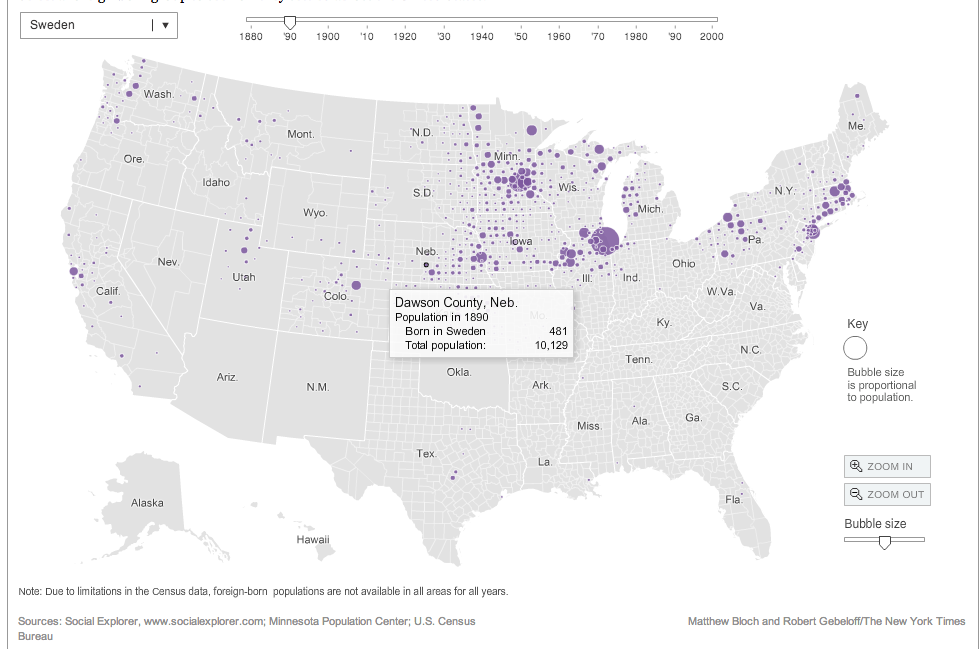Interactive Immigration Maps:
NY Times Immigration Explorer
This is a very nice historical map that lets you explore not only different ethnic groups, but also different time periods as well. This is a great map to look at regions where immigrants settled, like the Swedish population in Gothenburg Nebraska. This can be a fun little discussion starter or tool for students to compare/contrast immigration groups over time.
Can you pass the Citizenship Test?
When we talk about Immigration I usually use this as a time to talk about how Immigration Law has changed throughout US History. One fun little activity I have students is see if they could pass the US Citizenship test that is offered to immigrants today wishing to become US Citizens.Preparing for the Oath is a great online quiz offered by the National Museum of US History.
iCivics:
iCivics has lots of great educational games about Government, and Immigration Nation is another great game for students to learn about the process of immigration today. This is a good way to introduce students to the process of immigration today. Have students play the game and use a collaborate tool like TodaysMeet, Padlet, or Socrative for students to share what they have learned.
The Immigration Experience Project
During this unit we look at Immigration generally throughout US History, but our primary focus is on the large influx of immigrants who came toward the end of the 19th century and the beginning of the 20th century. Students create a "fictional" immigrant that can be based on their own family immigration story and create a Digital Scrap Book of their experience.Students can create their Scrapbook using iMovie, Keynote, ComicLife, and something I am hoping to try new this year is letting students create an eBook with iBooks Author.
Student Examples
Students use some information from our textbooks, but here are some other great tools to help students get an understanding of the immigrants experience coming to the US.
Scholasitc: Immigration - Stories Of Yesterday And Day
This website from scholastic has a treasure trove of interactives and resources for you and your students to explore. Visit the Virtual Field Trip which is a short video that is full of information about the History of Ellis Island and the immigrants who passed through this check point. You will follow an immigrants journey through Explore Ellis Island. You can also take a in depth look at some of the different places that immigrants went through in their journey to America. The website also has some really good graphs to help you Explore Immigration Numbers for you and your students to examine historical immigration trends. The site also has Meet Young Immigrants of today to help students see how immigration still impacts the United States Today. Although the site is directed more towards Elementary age students, Middle School students can still get a lot of information from this website.
Tenement Museum Interactive Experience: This is a great website to lets students take the role of an immigrant and they have to make certain choices on their way to the US. There is lots of great information and videos that go with this site. Once the student has successfully immigrated, there is also a great 360 Virtual tour of life in a tenement in New York that students can explore.
Ellis Island: Interactive Than and Now This interactive from the History Channel is a neat picture that looks at how Ellis Island looks today and what it looked like in the early 1900's. The History Channel also has some pretty good short video segments like Ellis Island Medical Inspections Video that are good informational videos for students to watch to learn about Immigration on Ellis Island.
Immigration from the Library of Congress. Has detailed information about several ethnic groups journey to the US.
immigration: The living mosaic of people: Is a study created website for a project and has lots of good information about a wide variety of immigrant groups.
What are some resources you use for helping students learn about US Immigration? I would love to hear about them in the comments section below.
What are some resources you use for helping students learn about US Immigration? I would love to hear about them in the comments section below.



